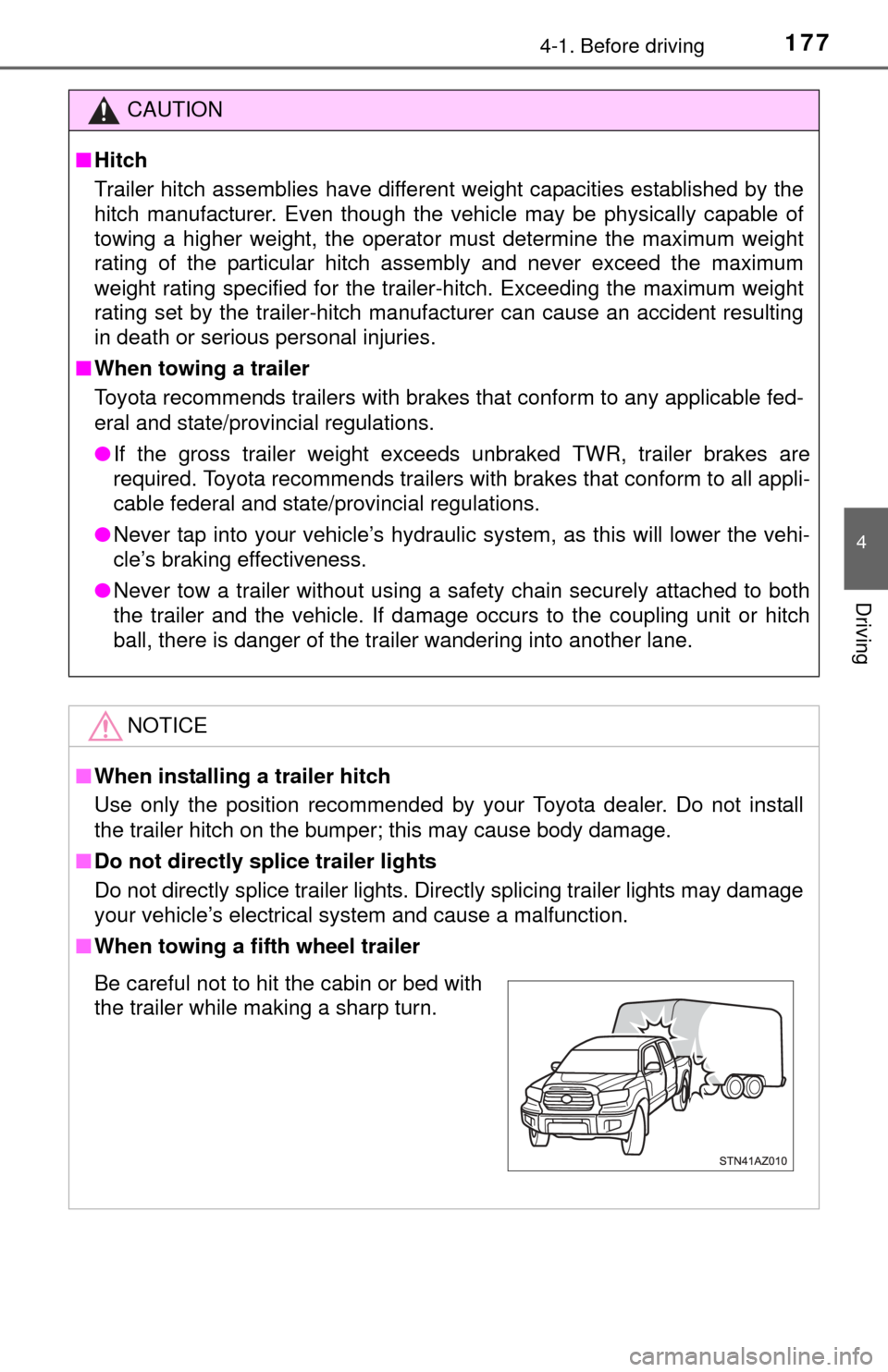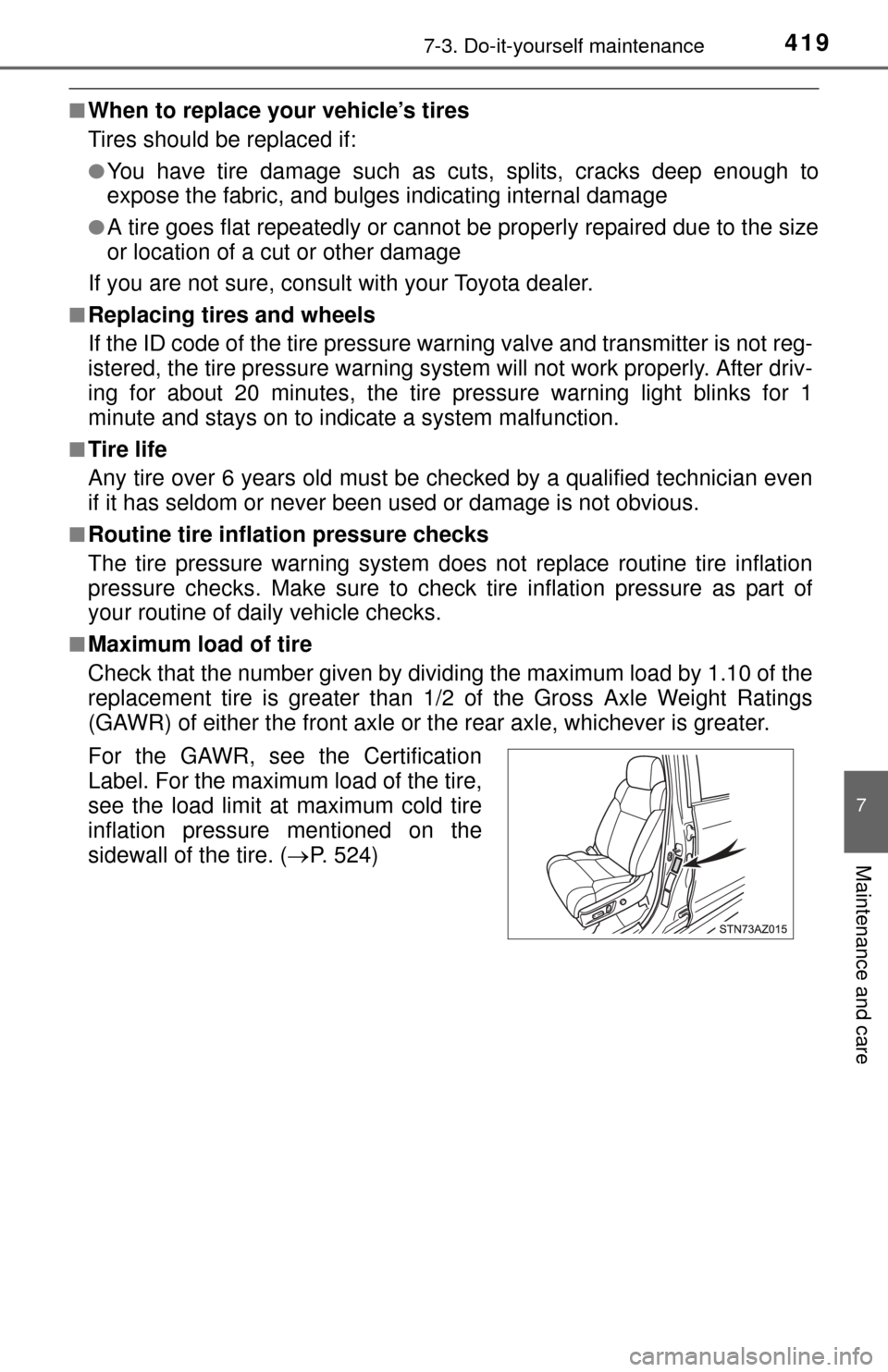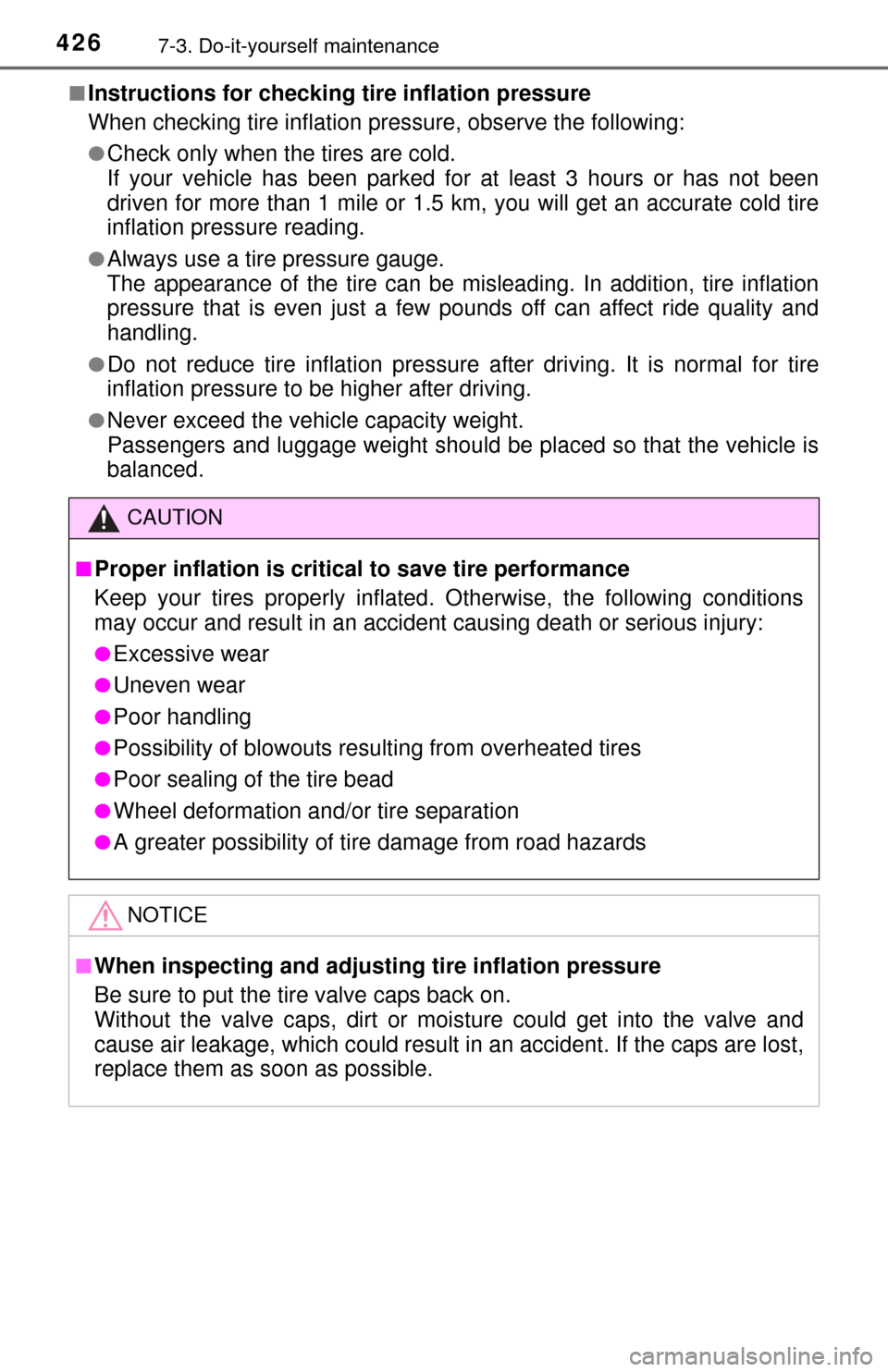Page 176 of 576

1764-1. Before driving
CAUTION
■To avoid accident or injury
● Do not exceed the TWR, unbraked TWR, GCWR, GVWR or GAWR.
● If the gross trailer weight is over 2000 lb. (907 kg), a sway control device
with sufficient capacity is required.
● If the gross trailer weight is over 5000 lb. (2268 kg), a weight distributing
hitch with sufficient capacity is required.
● Adjust the tongue weight within the appropriate range. Place heavier loads
as close to the trailer axle as possible.
● Do not exceed 65 mph (104 km/h), the posted towing speed limit or the
speed limit for your trailer as set forth in your trailer owner’s manual,
whichever is lowest. Slow down sufficiently before making a turn, in cross-
winds, on wet or slippery surface, etc., to help avoid an accident. If you
experience a vehicle-trailer instability from reducing a certain speed, slow
down and make sure you keep your vehicle speed under the speed of
which you experience the instability.
● Do not make jerky, abrupt or sharp turns.
● Do not apply the brakes suddenly as you may skid, resulting in jackknifing
and loss of vehicle control. This is especially true on wet or slippery sur-
faces.
● Do not exceed the trailer hitch assembly weight, gross vehicle weight,
gross axle weight and trailer tongue weight capacities.
● Do not use cruise control when towing.
● Slow down and downshift before descending steep or long downhill
grades. Do not make sudden downshifts while descending steep or long
downhill grades.
● Vehicle-trailer instability is more likely on steep long downhills. Before
descending steep or long downhill grades, slow down and downshift. Do
not make sudden downshifts when descending steep or long downhill
grades. Avoid holding the brake pedal down too long or applying the
brakes too frequently. This could cause the brakes to overheat and result
in reduced braking efficiency.
● Do not tow a trailer when the temporary spare tire is installed on your vehi-
cle.
Page 177 of 576

1774-1. Before driving
4
Driving
CAUTION
■Hitch
Trailer hitch assemblies have different weight capacities established by the
hitch manufacturer. Even though the vehicle may be physically capable of
towing a higher weight, the operator must determine the maximum weight
rating of the particular hitch assembly and never exceed the maximum
weight rating specified for the trailer-hitch. Exceeding the maximum weight
rating set by the trailer-hitch manufacturer can cause an accident resulting
in death or serious personal injuries.
■ When towing a trailer
Toyota recommends trailers with brakes that conform to any applicable fed-
eral and state/provincial regulations.
● If the gross trailer weight exceeds unbraked TWR, trailer brakes are
required. Toyota recommends trailers with brakes that conform to all appli-
cable federal and state/provincial regulations.
● Never tap into your vehicle’s hydraulic system, as this will lower the vehi-
cle’s braking effectiveness.
● Never tow a trailer without using a safety chain securely attached to both
the trailer and the vehicle. If damage occurs to the coupling unit or hitch
ball, there is danger of the trailer wandering into another lane.
NOTICE
■When installing a trailer hitch
Use only the position recommended by your Toyota dealer. Do not install
the trailer hitch on the bumper; this may cause body damage.
■ Do not directly splice trailer lights
Do not directly splice trailer lights. Directly splicing trailer lights may damage
your vehicle’s electrical system and cause a malfunction.
■ When towing a fifth wheel trailer
Be careful not to hit the cabin or bed with
the trailer while making a sharp turn.
Page 419 of 576

4197-3. Do-it-yourself maintenance
7
Maintenance and care
■When to replace your vehicle’s tires
Tires should be replaced if:
●You have tire damage such as cuts, splits, cracks deep enough to
expose the fabric, and bulges indicating internal damage
●A tire goes flat repeatedly or cannot be properly repaired due to the size
or location of a cut or other damage
If you are not sure, consult with your Toyota dealer.
■Replacing tires and wheels
If the ID code of the tire pressure warning valve and transmitter is not reg-
istered, the tire pressure warning system will not work properly. After driv-
ing for about 20 minutes, the tire pressure warning light blinks for 1
minute and stays on to indicate a system malfunction.
■Tire life
Any tire over 6 years old must be checked by a qualified technician even
if it has seldom or never been used or damage is not obvious.
■Routine tire inflation pressure checks
The tire pressure warning system does not replace routine tire inflation
pressure checks. Make sure to check tire inflation pressure as part of
your routine of daily vehicle checks.
■Maximum load of tire
Check that the number given by dividing the maximum load by 1.10 of the
replacement tire is greater than 1/ 2 of the Gross Axle Weight Ratings
(GAWR) of either the front axle or the rear axle, whichever is greater.
For the GAWR, see the Certification
Label. For the maximum load of the tire,
see the load limit at maximum cold tire
inflation pressure mentioned on the
sidewall of the tire. ( P. 524)
Page 426 of 576

4267-3. Do-it-yourself maintenance
■Instructions for checking tire inflation pressure
When checking tire inflation pressure, observe the following:
●Check only when the tires are cold.
If your vehicle has been parked for at least 3 hours or has not been
driven for more than 1 mile or 1.5 km, you will get an accurate cold tire
inflation pressure reading.
●Always use a tire pressure gauge.
The appearance of the tire can be misleading. In addition, tire inflation
pressure that is even just a few p ounds off can affect ride quality and
handling.
●Do not reduce tire inflation pressure after driving. It is normal for tire
inflation pressure to be higher after driving.
●Never exceed the vehicle capacity weight.
Passengers and luggage weight should be placed so that the vehicle is
balanced.
CAUTION
■Proper inflation is critical to save tire performance
Keep your tires properly inflated . Otherwise, the following conditions
may occur and result in an accident causing death or serious injury:
●Excessive wear
●Uneven wear
●Poor handling
●Possibility of blowouts result ing from overheated tires
●Poor sealing of the tire bead
●Wheel deformation and/or tire separation
●A greater possibility of tire damage from road hazards
NOTICE
■When inspecting and adjusting tire inflation pressure
Be sure to put the tire valve caps back on.
Without the valve caps, dirt or moisture could get into the valve and
cause air leakage, which could result in an accident. If the caps are lost,
replace them as soon as possible.
Page 427 of 576

4277-3. Do-it-yourself maintenance
7
Maintenance and care
Wheels
When replacing wheels, care should be taken to ensure that they are
equivalent to those removed in load capacity, diameter, rim width and
inset
*.
Replacement wheels are available at your Toyota dealer.
*: Conventionally referred to as “offset”.
Toyota does not recommend using the following:
● Wheels of different sizes or types
● Used wheels
● Bent wheels that have been straightened
● Use only Toyota wheel nuts and wrenches designed for use with
your aluminum wheels.
● When rotating, repairing or changi ng your tires, check that the
wheel nuts are still tight after driving 1000 miles (1600 km).
● Be careful not to damage the aluminum wheels when using tire
chains.
● Use only Toyota genuine balance weights or equivalent and a plas-
tic or rubber hammer when balancing your wheels.
If a wheel is bent, cracked or heavily corroded, it should be
replaced. Otherwise, the tire may separate from the wheel or
cause a loss of handling control.
Wheel selection
Aluminum wheel precautions (if equipped)
Page 504 of 576
5049-1. Specifications
Regular Cab models
*1: The model code is indicated on the Certification Label. (P. 510)
*2: Vehicles with towing package
*3: Vehicles with towing package and large fuel tank
*4: Vehicles without option
Vehicle capacity weight
Model code*1EngineDriving
systemBed type
Vehicle capacity weight
(Occupants + luggage)
USK51L-THTSKA 3UR-FE engine 2WD
Long
1965 lb. (890 kg)
1890 lb. (855 kg)*2
1770 lb. (800 kg)*3
2035 lb. (920 kg)*4
USK56L-THTSKA 4WD
1905 lb. (860 kg)
1830 lb. (830 kg)*2
1710 lb. (775 kg)*3
USK56L-THTSGA3UR-FBE
engine 4WD
1905 lb. (860 kg)
1830 lb. (830 kg)*2
1710 lb. (775 kg)*3
Page 505 of 576
5059-1. Specifications
9
Vehicle specifications
Double Cab models
Model code*1EngineDriving
systemBed type
Vehicle capacity weight
(Occupants + luggage)
UPK51L-CRTSKA 1UR-FE
engine 2WD
Standard
1405 lb. (635 kg)
UPK56L-CRTSKA 4WD
1315 lb. (595 kg)
USK51L-CRTSKA
3UR-FE engine 2WD
Standard
1590 lb. (720 kg)
1515 lb. (685 kg)*2
1390 lb. (630 kg)*3
USK51L-CRTLKA
1560 lb. (705 kg)
1485 lb. (670 kg)*2
1365 lb. (615 kg)*3
USK52L-CHTSKA
Long
1560 lb. (705 kg)
1485 lb. (670 kg)*2
1365 lb. (615 kg)*3
USK56L-CRTSKA
4WDStandard
1495 lb. (675 kg)
1425 lb. (645 kg)*2
1300 lb. (585 kg)*3
USK56L-CRTLKA
1490 lb. (675 kg)
1415 lb. (640 kg)*2
1295 lb. (585 kg)*3
USK57L-CHTSKA
Long
1475 lb. (665 kg)
1405 lb. (635 kg)*2
1280 lb. (580 kg)*3
Page 506 of 576
5069-1. Specifications
*1: The model code is indicated on the Certification Label. (P. 510)
*2: Vehicles with towing package
*3: Vehicles with towing package and large fuel tank
Model code*1EngineDriving
systemBed type
Vehicle capacity
weight
(Occupants + luggage)
USK56L-CRTSGA
3UR-FBE engine 4WDStandard
1495 lb. (675 kg)
1425 lb. (645 kg)*2
1300 lb. (585 kg)*3
USK56L-CRTLGA
1490 lb. (675 kg)
1415 lb. (640 kg)*2
1295 lb. (585 kg)*3
USK57L-CHTSGA
Long
1475 lb. (665 kg)
1405 lb. (635 kg)*2
1280 lb. (580 kg)*3